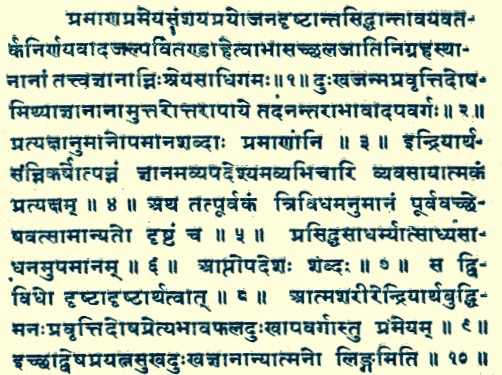|
Nyaya
Nyāya (Sanskrit: न्यायः, IAST: nyāyaḥ), literally meaning "justice", "rules", "method" or "judgment", is one of the six orthodox (Āstika) schools of Hindu philosophy. Nyāya's most significant contributions to Indian philosophy were the systematic development of the theory of logic, methodology, and its treatises on epistemology. Nyāya epistemology accepts four out of six ''pramanas'' as reliable means of gaining knowledge – ''pratyakṣa'' (perception), ''anumāṇa'' (inference), ''upamāna'' (comparison and analogy) and ''śabda'' (word, testimony of past or present reliable experts).John A. Grimes, A Concise Dictionary of Indian Philosophy: Sanskrit Terms Defined in English, State University of New York Press, , page 238DPS Bhawuk (2011), Spirituality and Indian Psychology (Editor: Anthony Marsella), Springer, , page 172Gavin Flood, An Introduction to Hinduism, Cambridge University Press, , page 225 In its metaphysics, Nyāya school is closer to the Vaish ... [...More Info...] [...Related Items...] OR: [Wikipedia] [Google] [Baidu] |
Nyāya Sūtras
The ''Nyāya Sūtras'' is an ancient Indian Sanskrit text composed by , and the foundational text of the Nyaya school of Hindu philosophy. The date when the text was composed, and the biography of its author is unknown, but variously estimated between 6th-century BCE and 2nd-century CE.Jeaneane Fowler (2002), Perspectives of Reality: An Introduction to the Philosophy of Hinduism, Sussex Academic Press, , page 129 The text may have been composed by more than one author, over a period of time. The text consists of five books, with two chapters in each book, with a cumulative total of 528 aphoristic sutras, about rules of reason, logic, epistemology and metaphysics.Jeaneane Fowler (2002), Perspectives of Reality: An Introduction to the Philosophy of Hinduism, Sussex Academic Press, , pages 127–136 The Nyāya Sūtras is a Hindu text, notable for focusing on knowledge and logic, and making no mention of Vedic rituals. The first book is structured as a general introduction and ... [...More Info...] [...Related Items...] OR: [Wikipedia] [Google] [Baidu] |
Epistemology
Epistemology is the branch of philosophy that examines the nature, origin, and limits of knowledge. Also called "the theory of knowledge", it explores different types of knowledge, such as propositional knowledge about facts, practical knowledge in the form of skills, and knowledge by acquaintance as a familiarity through experience. Epistemologists study the concepts of belief, truth, and justification to understand the nature of knowledge. To discover how knowledge arises, they investigate sources of justification, such as perception, introspection, memory, reason, and testimony. The school of skepticism questions the human ability to attain knowledge while fallibilism says that knowledge is never certain. Empiricists hold that all knowledge comes from sense experience, whereas rationalists believe that some knowledge does not depend on it. Coherentists argue that a belief is justified if it coheres with other beliefs. Foundationalists, by contrast, maintain th ... [...More Info...] [...Related Items...] OR: [Wikipedia] [Google] [Baidu] |
Ātman (Hinduism)
''Ātman'' (; ) is a Sanskrit word for the true or eternal Self or the self-existent essence or an impersonal (''it'') witness-consciousness within each individual. Atman is conceptually different from Jīvātman, which persists across multiple bodies and lifetimes. Some schools of Indian philosophy regard the ''Ātman'' as distinct from the material or mortal ego ('' Ahankara''), the emotional aspect of the mind ('' Citta''), and existence in an embodied form ('' Prakṛti''). The term is often translated as soul, but is better translated as "Self", as it solely refers to pure consciousness or witness-consciousness, beyond identification with phenomena. In order to attain moksha (liberation), a human being must acquire self-knowledge ('' Atma Gyaan or Brahmajnana''). ''Ātman'' is a central concept in the various schools of Indian philosophy, which have different views on the relation between ''Atman'', individual Self ('' Jīvātman''), supreme Self ('' Paramātmā'') a ... [...More Info...] [...Related Items...] OR: [Wikipedia] [Google] [Baidu] |
Gautam Ashram
Gautam Ashram () was a gurukul of the ancient Indian philosopher Gautama. It is located at the west bank of Khiroi river in Brahmpur village of Jale block of Darbhanga district in Bihar. It is only at a seven kilometres distance from Kamtaul railway station. Background It is believed that Akshapada Gautama wrote his famous book Nyaya Shastra at this place. There is also a very famous pond known as Gautam Kund, where Gautam Rishi took his bath daily. It is believed that this Kund was brought by the sage Gautama as symbolic Ganga near his Ashram. Therefore it is also known as ''Gautami Ganga''. Aksapada Gautama was the Acharya of the Ancient Mithila University. He taught Nyaya Shastra to his disciples. So this place was also a Gurukul of the Ancient Mithila University. Nearby the ashram, there is Ahilya Sthan related to Ahilya. Ahilya was the wife of Gautam Rishi. Gautam Ashram and Ahilya Sthan have a great importance in the history of ancient Mithila. In Puranas In the ... [...More Info...] [...Related Items...] OR: [Wikipedia] [Google] [Baidu] |
Hindu Philosophy
Hindu philosophy or Vedic philosophy is the set of philosophical systems that developed in tandem with the first Hinduism, Hindu religious traditions during the Iron Age in India, iron and Classical India, classical ages of India. In Indian philosophy, of which Hindu philosophy is a prominent subset, the word used for philosophy is ''Darshana'' (Sanskrit: दर्शन; meaning: "viewpoint or perspective"), from the Sanskrit root 'दृश' () meaning 'to see, to experience'. The schools of thought or ''Darshanas'' within Hindu philosophy largely equate to the six ancient orthodox schools: the ''Āstika and nāstika, āstika'' (Sanskrit: आस्तिक) schools, defined by their acceptance of the Vedas, the oldest collection of Sanskrit literature, Sanskrit texts, as an authoritative source of knowledge. Of these six, Samkhya (सांख्य) is the earliest school of Dualism (Indian philosophy), dualism; Yoga (philosophy), Yoga (योग) combines the metaphysics ... [...More Info...] [...Related Items...] OR: [Wikipedia] [Google] [Baidu] |
Sanskrit
Sanskrit (; stem form ; nominal singular , ,) is a classical language belonging to the Indo-Aryan languages, Indo-Aryan branch of the Indo-European languages. It arose in northwest South Asia after its predecessor languages had Trans-cultural diffusion, diffused there from the northwest in the late Bronze Age#South Asia, Bronze Age. Sanskrit is the sacred language of Hinduism, the language of classical Hindu philosophy, and of historical texts of Buddhism and Jainism. It was a lingua franca, link language in ancient and medieval South Asia, and upon transmission of Hindu and Buddhist culture to Southeast Asia, East Asia and Central Asia in the early medieval era, it became a language of religion and high culture, and of the political elites in some of these regions. As a result, Sanskrit had a lasting effect on the languages of South Asia, Southeast Asia and East Asia, especially in their formal and learned vocabularies. Sanskrit generally connotes several Indo-Aryan languages# ... [...More Info...] [...Related Items...] OR: [Wikipedia] [Google] [Baidu] |
Francis Xavier Clooney
Francis Xavier Clooney (born 1950) is an American Jesuit priest and scholar in the teachings of Hinduism. He is currently a professor at Harvard Divinity School in Cambridge, Massachusetts. Career A native of Brooklyn, New York, he graduated from Regis High School in Manhattan and entered the novitiate of Society of Jesus in 1968 and was subsequently ordained in 1978. Following that, he earned his bachelor's degree at Fordham University in the Bronx, New York. After earning his doctorate in South Asian Languages and Civilizations at the University of Chicago in 1984, Clooney taught at Boston College until 2005, serving also as the Academic Director of the Oxford Centre for Hindu Studies (a recognised independent centre of the University of Oxford), when he became the Parkman Professor of Divinity and Professor of Comparative Theology at Harvard Divinity School. In 2010, he became the Director of Harvard's Center for the Study of World Religions but is no longer in that rol ... [...More Info...] [...Related Items...] OR: [Wikipedia] [Google] [Baidu] |
Gautama Maharishi
Gautama (, ), was a sage in Hinduism and son of Brahmin sage Dirghatamas who is also mentioned in Jainism and Buddhism. Gautama is mentioned in the Yajurveda, Ramayana, and Ganesha Purana, Gaṇeśa Pūrana and is known for cursing his wife Ahalya, Ahalyā. Another important story related to Gautama is about the creation of river Godavari River, Godavari, which is also known as Gautami. Children According to the Ramayana, Gautama's eldest son with Ahalya is Shatananda. But according to the Adi Parva of Mahabharata, he had two sons named Sharadvana and Cirakari. Sharadvana was also known as Gautama, hence his children Kripa and Kripi were called Gautama and Gautami respectively. A daughter of Gautama is referred too, but her name is never disclosed in the epic. In the Sabha Parva, he is described to beget many children through Aushinara (daughter of Ushinara), amongst whom the eldest in Kakshivata. Gautama and Aushinara's wedding takes place at Magadha, the kingdom of Jarasandha. ... [...More Info...] [...Related Items...] OR: [Wikipedia] [Google] [Baidu] |
Chaitra
Chaitra () is a month of the Hindu calendar. In the standard Hindu calendar and India's national civil calendar, Chaitra is the first month of the year. It is the last month in the Bengali calendar, where it is called Choitro. Chaitra or Chait is also the last month in the Nepali calendar (the Vikram Samvat), where it commences in mid-March. Chittirai is the first month in the Tamil calendar. In the Sindhi calendar, this month is referred to as Chet and is marked by the celebration of the Cheti Chand (birth of Jhulelal, an incarnation of Vishnu). In the Vaishnava calendar, Vishnu governs this month. In solar religious calendars, Chaitra begins with the Sun's entry into Aries. In the more traditional reckoning, the first month commences in March or April of the Gregorian calendar, depending upon whether the adhika masa (extra month for alignment of lunar or solar calendar) was observed in the year. The first day of Chaitra is marked as the , the Hindu lunar new year. N ... [...More Info...] [...Related Items...] OR: [Wikipedia] [Google] [Baidu] |
Ahalya
In Hinduism, Ahalya (, IAST: Ahalyā) also spelt as Ahilya, is the wife of the sage Gautama Maharishi. Many Hindu scriptures describe her legend of seduction by the king of the gods Indra, her husband's curse for her infidelity, and her liberation from the curse by the god Rama. Created by the god Brahma as the most beautiful woman, Ahalya was married to the much older Gautama. In the earliest full narrative, when Indra comes disguised as her husband, Ahalya sees through his disguise but nevertheless accepts his advances. Later sources often absolve her of all guilt, describing how she falls prey to Indra's trickery. In all narratives, Ahalya and Indra are cursed by Gautama. The curse varies from text to text, but almost all versions describe Rama as the eventual agent of her liberation and redemption. Although early texts describe how Ahalya must atone by undergoing severe penance while remaining invisible to the world and how she is purified by offering Rama hospitality, in ... [...More Info...] [...Related Items...] OR: [Wikipedia] [Google] [Baidu] |
Anviksiki
Ānvīkṣikī is a term in Sanskrit denoting roughly the "science of inquiry" and it should have been recognized in India as a distinct branch of learning as early as 650 BCE. However, over the centuries its meaning and importance have undergone considerable variations. In the earliest period, the term was used to denote Atma-vidya, the science of the soul, in contrast to Adhyatma-vidya, the spiritual science, or Brahma-vidya, the divine science. In Manu Smriti the term Ānvīkṣikī has been used as equivalent to Atma-vidya and it has been described as a branch of the Vedas. In the fourth century BCE, Kautilya in his Arthashastra recognised it as a distinct branch of learning different from Vedas and other disciplines. Kautilya classifies all disciplines into four categories: scripture (the three Vedas, ''trayi''), agriculture and commerce (''varta''), politics and public administration (''danda-niti''), and ''Ānvīkṣikī'', the investigative reflective science. The distincti ... [...More Info...] [...Related Items...] OR: [Wikipedia] [Google] [Baidu] |






